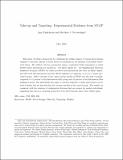Take-up and Targeting: Experimental Evidence from SNAP
Author(s)
Finkelstein, Amy; Notowidigdo, Matthew J.
DownloadAFinkelstein_Takeup_and_Targeting.pdf (728.2Kb)
Additional downloads
Open Access Policy
Open Access Policy
Creative Commons Attribution-Noncommercial-Share Alike
Terms of use
Metadata
Show full item recordAbstract
This paper develops a framework for evaluating the welfare impact of various interventions designed to increase take-up of social safety net programs in the presence of potential behavioral biases. We calibrate the key parameters using a randomized field experiment in which 30,000 elderly individuals not enrolled in – but likely eligible for – the Supplemental Nutrition Assistance Program (SNAP) are either provided with information that they are likely eligible, provided with this information and also offered assistance in applying, or are in a “status quo” control group. Only 6 percent of the control group enrolls in SNAP over the next 9 months, compared to 11 percent of the Information Only group and 18 percent of the Information Plus Assistance group. The individuals who apply or enroll in response to either intervention receive lower benefits and are less sick than the average enrollee in the control group. The results are consistent with the existence of optimization frictions that are greater for needier individuals, suggesting that the poor targeting properties of the interventions reduce their welfare gains.
Date issued
2018-05Department
Massachusetts Institute of Technology. Department of EconomicsJournal
Quarterly Journal of Economics
Publisher
National Bureau of Economic Research
Citation
Finkelstein, Amy and Matthew J Notowidigdo. "Take-Up and Targeting: Experimental Evidence from SNAP," The Quarterly Journal of Economics, 134, 3, (May 2019): 1505-1556
Version: Original manuscript
ISSN
1531-4650